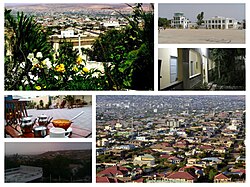Hargeisa
Hargeisa
Hargeysa هرجيسا | |
|---|---|
City | |
 | |
| Country | |
| Region | Woqooyi Galbeed |
| 26 June 1960 (State of Somaliland) | |
| 1 July 1960 (Somali Republic) | |
| Government | |
| • Mayor | Abdurrahman Mahmoud Aidiid |
| Population (2000 est.)[1] | |
| • Total | 1,200,000 |
| Time zone | UTC+3 (EAT) |
Hargeisa ([Hargeysa] Error: {{Lang-xx}}: text has italic markup (help), Arabic: هرجيسا, "little Harar") is a city in the western Woqooyi Galbeed province of Somaliland. It is the largest city in the country , the national capital.[2][3] Hargeisa serves as the capital of Somaliland, a self-declared republic that is internationally not recognized [4]
During the Middle Ages, Hargeisa was part of the Adal Sultanate's domain. The city later succeeded Berbera as the capital of the British Somaliland protectorate in 1941. In 1960, the protectorate gained independence as the State of Somaliland and united as scheduled days later with the Trust Territory of Somalia (the former Italian Somaliland) to form the Somali Republic.[5][6]
Hargeisa is situated in a valley in the Galgodon (Ogo) highlands, and sits at an elevation of 4,377 feet (1,334 m). Home to rock art from the Neolithic period, the city is also a commercial hub for precious stone-cutting, construction, retail services and importing/exporting, among other activities.[2]
Etymology
The place-name Hargeisa literally means "the place where hide is sold".[7] Although little is known about the city's pre-19th century history,[7] Encyclopaedia Aethiopica suggests that the settlement may have evolved in the latter half of the 1800s as a Qadiriyya settlement established by Shaykh Maddar, near a water-stop used by nomadic stock-herders on the way to the town of Harar. It thus proposes that the name "Hargeisa" was possibly derived from the sobriquet Harar as-sagir, meaning "Harar the little".[8]
History
Prehistory

Numerous cave paintings from the Neolithic period are found in the Laas Gaal complex, on the outskirts of Hargeisa. During November and December 2002, an archaeological survey was carried out in the area by a French team of researchers. The expedition's objective was to search for rock shelters and caves containing stratified archaeological infills capable of documenting the period when production economy appeared in this part of Somalia (circa 5,000 and 2,000 BCE). During the course of the survey, the French archaeological team discovered the Laas Gaal rock art, encompassing an area of ten rock alcoves (caves). In an excellent state of preservation, the paintings show human figures with their hands raised and facing long-horned, humpless cattle.[9]
The rock art had been known to the area's inhabitants for centuries before the French discovery. However, the existence of the site had not been broadcast to the international community. In November 2003, a mission returned to Laas Gaal and a team of experts undertook a detailed study of the paintings and their prehistoric context.
Somaliland in general is home to numerous such archaeological sites, with similar rock art and/or ancient edifices found at Haylaan, Qa’ableh, Qombo'ul and Elaayo. However, many of these old structures have yet to be properly explored, a process which would help shed further light on local history and facilitate their preservation for posterity.[10]
British Somaliland

In 1888, after signing successive treaties with the then ruling Somali Sultans such as Mohamoud Ali Shire of the Warsangali Sultanate, the British established a protectorate in the region referred to as British Somaliland.[11] The British garrisoned the protectorate from Aden in present-day Yemen, and administered it from their British India until 1898. British Somaliland was then administered by the Foreign Office until 1905 and afterwards by the Colonial Office.
Berbera, a major trading harbour on the Red Sea, was the protectorate's first capital due to its strategic importance. However, the capital was moved from Berbera to Hargeisa, and the city was granted capital status in 1941. During the East African Campaign, the protectorate was occupied by Italy in August 1940, but recaptured by the British in March 1941.
The protectorate gained its independence on 26 June 1960 as the State of Somaliland,<ref name="nytimes6">
- ^ Hargeisa City Hall. Retrieved on 2012-10-17. (2000 est.)
- ^ a b "Hargeisa". Jubba Airways. Retrieved 18 July 2013.
- ^ "Somalia: largest cities and towns and statistics of their population". world-gazetteer.com. Archived from the original on 9 February 2013. Retrieved October 19, 2012.
- ^ [1] Somaliland’s Quest for International Recognition and the HBM-SSC Factor
- ^ Worldstatesmen – Somalia
- ^ Encyclopædia Britannica, The New Encyclopædia Britannica, (Encyclopædia Britannica: 2002), p.835
- ^ a b Briggs, Philip (2012). Somaliland: With Addis Ababa & Eastern Ethiopia. Bradt Travel Guides. p. 10. ISBN 1841623717.
- ^ Ficadorey, Gianfranco (2008). "Ha". Basic Reference. 3. NY, USA: Thomson/Gale: 1032.
- ^ The Journal of African Archeology Volume 1.2 (2003) Chapter 3
- ^ Michael Hodd, East African Handbook, (Trade & Travel Publications: 1994), p.640.
- ^ Hugh Chisholm (ed.), The encyclopædia britannica: a dictionary of arts, sciences, literature and general information, Volume 25, (At the University press: 1911), p.383.
